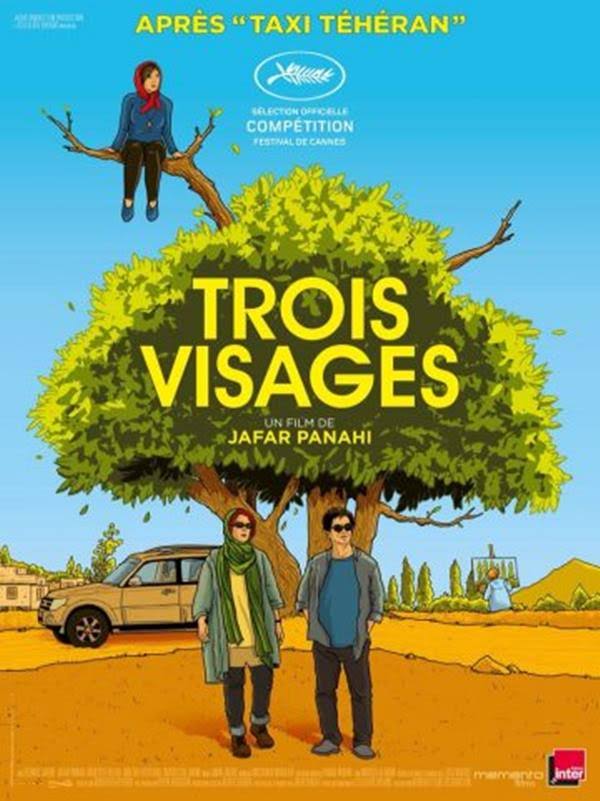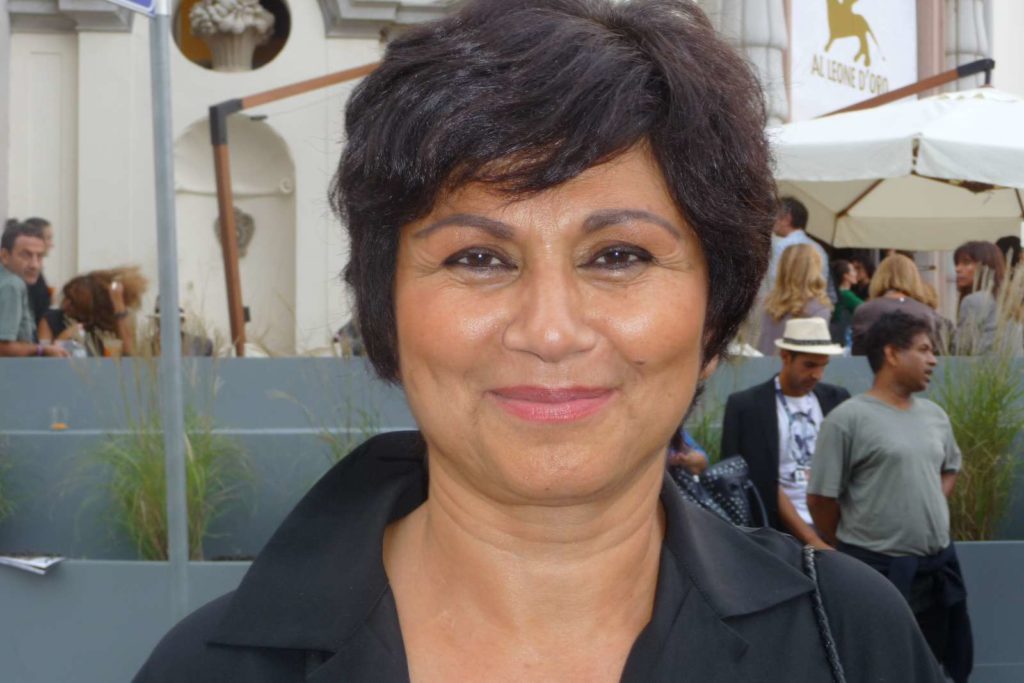Armanshahr | 40Braids
Shahla Rostami
“3 Faces”, the latest film by Iranian filmmaker, Jafar Panahi, after winning the Golden Palm for best script in Cannes Film Festival this year, has now come to the cinema screens in France. The film is a suspenseful road movie to a remote village on the Turkish border to investigate a mystery. The three faces are those of three strong free-spirited actresses of different ages who represent the past, the present and the future of the country against tradition and superstitious beliefs. Three women who want to build their own destinies. Their adventures reveal many issues rooted in Iranian society.
Jafar Panahi, ever since his first feature film; “The White Balloon” (Golden Camera in Cannes film festival, 1995) has created work which have been featured at numerous prestigious festivals have been acclaimed and received prizes. This time he could not come out of Iran to receive his prize in Cannes because of the work and travel ban put on him since 2010.
Jafar Panahi, like many of his other Iranian colleagues, has always been concerned about the status and fate of women. In his first two films, “White Balloon” and “Ainah” (Mirror), he portrays two little girls standing up for their rights. In “The Circle” (winner of the Golden Lion of the Venice film festival in 2000), Panahi depicts women who live under religious and political pressures. In “Offside” (2006), one of the most hard-hitting films by this director, once again, Panahi points out the issue of banning women from entering stadiums to watch soccer matches.
After the social unrest following the controversial election of Mahmoud Ahmadinejad in 2009, Jafar Panahi was arrested and underwent various condemnations in 2010, including a ban on his work. He did not give up and, despite the circumstances, made the movie “The Curtain” and then “Taxi Tehran”, which won the Golden Bear at the Berlin film Festival and marked 580,000 entrances in cinemas in France.
Today Jafar Panahi has once again returned to the world of cinema with “3 Faces” which has brought pride for himself and his country. In this movie, he departs from concerns of “Taxi Tehran”, which was based on various aspects of the daily life of Tehran citizens, depicting the personal problems of a number of characters in an urban area through short encounters. This time in just 82 minutes, Panahi moves beyond that experience, and takes us to other horizons and lives in a small village in Azerbaijan. The “3 faces” of Iranian women, does not just affect women, because in this case he would have to choose many more to show, but he goes deep down under Iran’s skin just like Abbas Kiarostami would do. In “3 Faces”, not only we find some similarities with Kiarostami’s style and approach (road, travel, search, death, grave, village life …), to whom, according to Jafar Panahi, the film should be considered as a tribute, but we witness the circularity of issues the way he had formulated in his own film “The Circle” (2000) ; the closed circle of restrictive conditions.
Another common point of this film with his previous works is the centrality of women; their issues and efforts to reach freedom and to guide their own fates.
Why this trip? To find a girl who says she is bored with her life’s conditions and not able to realize her dream of becoming an actress. Actress Behnaz Jafari, playing her own role, finds out through a video sent to Jafar Panahi’s mobile phone about the girl. In this video the girl stages her own suicide. Behnaz Jafari stops her work shooting a film and along with Jafar Panahi (also in his own role), hit the road in order to discover if the girl’s story is real or not.
Step by step, the director, either through dialogue or emphasis on nature, brings about an intriguing new question. With the appearance of a third woman, the forgotten artist who has cut herself off from the world to live in this remote corner of Iran, Panahi reminds us about another social reality : a society which constantly forgets its past idols but still yearns to create new ones. A society in which identity, instead of being linear and steadily changing, is subject to historical bumps and upheavals.
Humor and absurdity, like in the movie “Taxi Tehran”, is quite present in this new film. Among them, when the villagers surround the famous actress and express their interest, we see how quickly they turn their backs to the celebrity-strangers when they realize they haven’t come to offer help for their problems and difficulties. This move is very significant because it also shows the place of artists, and especially cinema celebrities, among people who take them as divinities and when artists do not react as a savior in the absence of caring authorities, they are disappointed. This shows the power of image and the creation of myths by cinema, this very influential medium. It also shows how a filmmaker, Panahi in this case, who lives in such particular restraining circumstances to perform his craft, still does his best in one way or the other and in spite of many complications, makes his films and continues his career as an artist and cinematographer.
This “Feel good” movie, which takes us on a trip inside Iran, also paved the way for Jafar Panahi, to enter the main competition section of the Cannes film Festival and win the best scenario prize. Of course, this was not the first time as he had been selected previously in other sections of Cannes film festival, namely “Un certain Regard”, where he won its prize in the past.
Hengameh Panahi; A woman in a man’s industry
Here I must add that Hengameh Panahi, the head of the highly acclaimed film company “Celluloid Dreams”, is the international distributor of the film and has been supporting Jafar Panahi’s body of work since the beginning.
Hengameh Panahi, who was born in Iran and lived in Belgium from the age of 12, founded the “Celluloid Dealers” Company in 1985, which later became “Celluloid Dreams”. She is one of the rare women in this highly masculine, competitive and somehow violent sector. She mostly worked on films which have not only been highlighted in festivals (“Taxi Tehran”, “Dheepan” and ” Afar “in the Berlinale, Cannes and Venice festivals, by referring only to the year 2015), but also very successful in the cinemas.
Hengameh Panahi, who lives in France since 1993, has also several Iranian filmmakers on her agenda, namely Abbas Kiarostami’s “Where is the friend’s house” and “Close-up”, Majid Majidi, Mohsen Makhmalbaf and Marjane Satrapi’s “Chicken with plums”.
Among the many directors with whom Hengameh Panahi has been working closely we can name Takeshi Kitano (with 16 films) and Jacques Audiard. This year, among the filmmakers present at the official competition of Cannes Film Festival, we could see the winner of the Palme d’or, Hirokazu Kore-eda and Jia Zhangke, with whom Hengameh Panahi has been collaborating with on several films. For instance the four first films of Hirokazu Kore-eda.
I asked Hengameh Panahi, who also produced “Taxi Tehran”, if this interest in Jafar Panahi’s work comes from the previous success of this filmmaker or was meant to support a very talented filmmaker struggling with difficulty or again for the specificity of Jafar Panahi?
Hengameh Panahi: I am faithful to all my filmmakers as long as they do not change producers who prefer another distributor. I think of myself as an editor, who chooses a writer and not a book; I choose a filmmaker and not a film, including Panahi.
What is the reason for this attachment and the production of his new film after “Taxi Tehran”? Support a good filmmaker or his particularity as a filmmaker?
Hengameh Panahi: Regarding Jafar Panahi, I took care of all his films except ‘This is not a movie’. It was therefore natural that I would also take care of the new one.
“3 Faces”, is considered (as Jafar says himself) as a tribute to Kiarostami by using some familiar elements of the late filmmaker’s works. To what extend is it similar or different from other works by Panahi?
Hengameh Panahi: When Jafar wants to shoot a film, he must not only write the script, but in parallel, imagine its feasibility within the limits that his situation imposes on him. For “3 Faces”, he chose to shoot outside of Tehran while his cinema is, with only one exception, anchored in the urban life of Tehran. Shooting in his grandparents’ village in Azerbaijan near the Turkish border, gave him the distance and confidentiality he needed. So, the arrival by car among the peasants of city-people created an immediate parallel with Abbas Kiarostami’s cinema. The winding little path in the countryside is also an iconic sign of the great master. But apart from these allusions which are a discreet tribute to his friend and mentor, Jafar’s new film is the continuity of his own personal and singular work and deals with themes of his own. For example, the film’s exposure to a filmed suicide would never have found its place in Abbas Kiarostami’s films. As for the big question of fiction or reality, it goes through not only all Iranian films, but also all Iranian society for understandable reasons. ‘Living and lying in Tehran’ by Ramita Navai is a beautiful testimony of this.
Had the success of “Taxi Tehran” encouraged you to renew your collaboration with Panahi or the new script convinced you?
Hengameh Panahi: I remind you that my editorial choice is based on the authors- filmmakers and as long as I have the opportunity I like to follow them all along their film-making process. Whether a film works or not has never been the issue, but to accompany them over time is what interests me.
Are there other young Iranian filmmakers newly introduced to festivals or movie theaters, who may interest you?
Hengameh Panahi : I really liked Ali Abbasi’s film called “Border” which I saw in Cannes. *
——————————————————-
* “Border” won the 2018 prize of Un Certain Regard at the Cannes Festival



